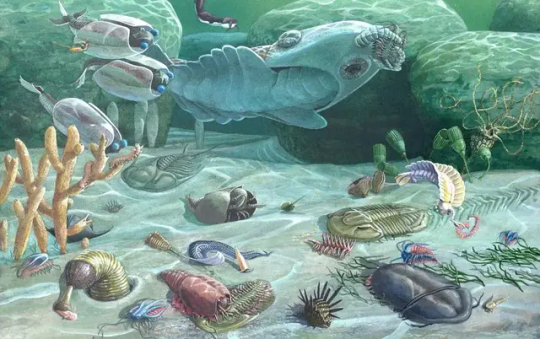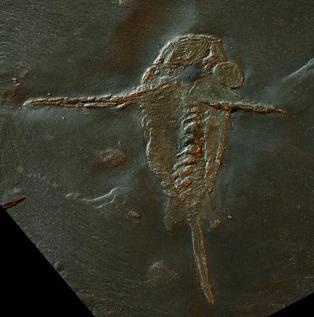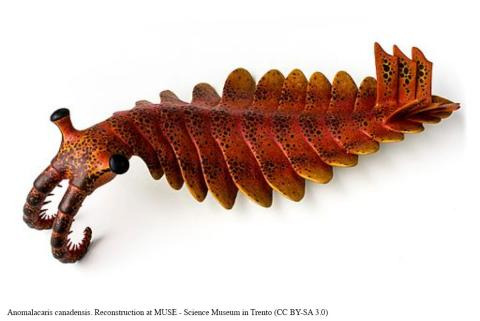#anomalocaridid
Explore tagged Tumblr posts
Text

the prettiest girls are top predators of the cambrian (original anomalocaris art by sebastian kaulitzki)
#scourge's art#angel's art#anomalocaris#cambrian explosion#cambrian period#cambrian#paleozoic#anomalocaridid#extinct animals#extinct species#gijinka#monster girl#humanization#animal gijinka#prehistoric#prehistoric animals#kawaii art#kawaii style#moe art
66 notes
·
View notes
Text

My favorite part about the Cambrian is that we see images like this, and we envision a modern human scubadiver swimming alongside the "largest species of the period," the Anomalocaridids, like they were cool insect whales or something.
The biggest guy in this picture was a foot and a quarter / ≤ 40 cm long. That's it. And its "enormous size" is what gave it an edge in this world.
If you went back here in a time machine and dipped a big bucket into the right part of the ocean, you'd be able to pick up everything it had to offer, barring some kind of giant jellyfish or something that hasn't fossilized well.
93 notes
·
View notes
Text





Schinderhannes bartelsi
(temporal range: 408-400 mio. years ago)
[text from the Wikipedia article, see also link above]
Schinderhannes bartelsi is a species of hurdiid radiodont (anomalocaridid) known from one specimen from the lower Devonian Hunsrück Slates. Its discovery was astonishing because previously, radiodonts were known only from exceptionally well-preserved fossil beds (Lagerstätten) from the Cambrian, 100 million years earlier.
5 notes
·
View notes
Text
@skxrbrand
Khrone's first form:

an anomalocaridids had enough thought to understand death and thus killing
5 notes
·
View notes
Photo


Cambrian Explosion #42: Radiodonta – The Strangest Shrimps
Once the dinocaridids started exploring active swimming lifestyles, one branch of this group quickly became incredibly successful and diverse: the radiodonts. With muscular swimming flaps, head carapaces, stalked compound eyes, disc-like mouths, and large spiny front appendages, they occupied a wide range of ecological roles – and some of them went on to became giants, some of the largest animals of their time.
They were some of the closest relatives to the ancestors of the true arthropods (or "euarthropods"). And while the earliest radiodont fossils are known from about 518 million years ago, much like other panarthropods their actual evolutionary origins have to go back much deeper into the early Cambrian since they already lived alongside representatives of various early euarthropod groups.
———
The first radiodont ever discovered is also the most famous of the group, Anomalocaris canadensis from the Canadian Burgess Shale deposits (~508 million years ago).
Initially discovered in the late 1880s, only isolated front appendages were found and they were misidentified at the time as being parts of crustaceans. In the early 1910s an individual mouth cone was thought to represent a jellyfish, and a fairly complete body fossil was interpreted as a sea cucumber. It wasn't until 1985 that all these separate pieces were finally recognized as belonging to one type of surprisingly large Cambrian animal, which was given the earliest name assigned to any of the constituent fossils – Anomalocaris, meaning "strange shrimp" – and thankfully that tuned out to be a very fitting name for a bizarre-looking distant cousin of crustaceans and other arthropods.
Since then around 35 different species of radiodonts have been discovered, and Anomalocaris has turned out to represent just one branch of this lineage.
It had 13 pairs of large body flaps and 3 smaller pairs on its neck region, along with a vertical three-part tail fan and rows of hair-like gills attached to each body segment along its back. Its stalked compound eyes were made up of around 16,000 lenses each, and it would have had incredibly sharp vision comparable to modern dragonflies. Several sclerites formed a carapace around its head, with a tri-radial mouth underneath and a pair of large jointed spiny appendages at the front.
While some past estimates of its size are now known to be rather exaggerated (or based on different radiodont species entirely), it was still a relatively huge animal for the time at around 50cm long (1'8"). Its raptorial front appendages suggest it was an apex predator, with a lack of wear on its mouthparts indicating it probably mostly fed on soft-bodied animals.
The closely-related Lenisicaris and several other still-unnamed species of Anomalocaris are known from various mid-Cambrian fossil sites that at the time were tropical or subtropical latitudes, showing that anomalocaridids were widespread in warm waters around the world. Ultimately these predatory radiodonts lasted for at least 20 million years during the mid-Cambrian, with the last known anomalocaridid fossils coming from the Weeks Formation in Utah, USA (~499 million years ago).
———
Related to the anomalocaridids, the amplectobeluid radiodonts had front appendages with a highly enlarged first spine, forming a specialized grasping pincer-like structure.
Amplectobelua symbrachiata is known from the Chinese Chengjiang fossil deposits (~518 million years ago) and was around the same size as Anomalocaris at about 50cm long (1'8"), making it one of the largest known Chengjiang animals.
It had 11 pairs of large swimming flaps with strengthening rays along their front edges, and while it's unclear if it had a tail fan it did have a pair of long streamer-like appendages at its rear end. Underneath the smaller pairs of flaps on its neck there were at least 3 pairs of "gnathobase-like structures" that would have been used to hold and shred up prey after transferring it from its pincer-like front appendages, chewing it up before passing it up to its mouth.
Several other amplectobeluids have been identified, including Lyrarapax and Ramskoeldia, and they also seem to have occurred mostly in tropical and subtropical waters during the mid-Cambrian. The latest known fossils of this family come from the Burgess Shale, about 508 million years ago, and much like their cousins the anomalocaridids they may have been wiped out around the time of the late Cambrian "SPICE" event, unable to cope with cooling oceans and rising anoxic conditions.
———
Nix Illustration | Tumblr | Twitter | Patreon
#science illustration#paleontology#paleoart#palaeoblr#cambrian explosion#cambrian explosion 2021#rise of the arthropods#anomalocaris#anomalocaridid#amplectobelua#amplectobeluid#radiodonta#dinocaridida#panarthropoda#ecdysozoa#protostome#bilateria#eumetazoa#animalia#art
181 notes
·
View notes
Photo

Anomalocaridid Underwater Ocean Panorama Baby Bib: available here!
#Anomalocaridid#underwaterart#underwater#underwaterlife#ocean#sea#atlantis#baby#baby bib#baby bibs#sfw agere#safe agere#crabs#creatures#shrimp#nudibranch#fish#shark#fishes#monsters#art#baby clothes#baby gear
3 notes
·
View notes
Photo

Anomalocaridid Underwater Ocean Panorama Wine Stopper: Bionic anomalocaridids! There are two of each species of anomalocaridid, including Anomalocaris, Laggania (or Peyotia), Schinderhannes and Amplectobelua. Hopefully I’ve got all of those right, I haven’t checked them so they might not be. The colours were based mainly on nudibranches, although the two Hurdia (the ones with the shell thing coming out of their faces) were based on crabs and the Anomalocaris in the foreground was based on a mantis shrimp.
Available here!
#anomalocaridid#anomalocaridids#nudibranches#shrimp#underwater#sea#ocean#ocean life#oceanlife#sealife#sea life#water#sunken city#atlantis#crabs#cuttlefish#hurdia#bionic#sci-fi#scifi#sci fi#science#robot#robotics#bionics#shark#fantasy#peyotia#mantis shrimp#wine stopper
1 note
·
View note
Text

How about a nice friend from the Cambrian Period?
ah shit I went too deep last night and found some VERY good and extremely accurate deep sea animal plushies and now I’m having to slap my hand off the mouse every 5 minutes so I can focus on work and not just go buy them all
30K notes
·
View notes
Photo

The first complete Anomalocaris fossil ever found.
62 notes
·
View notes
Text
I know they’re like. One of the most popular groups from the Cambrian Explosion, and are often awesome-bro’ed (if awesome-bros get invested in stem-arthropods)?
But I really do love the radiodonts. I love them so much, I think they’re just so hecking cool? They were so often the first experiment in filling niches we now take for granted, and I wish we still had them around.
#phoenix sounds#radiodonts#I'm still in the habit of calling them anomalocaridids whoops#I saw a talk at SICB 2018 about Anomalocaris canadensis' tailfin being used for lift and pulsing speed#And got so excited I almost cried#(There is a picture of me somewhere online ugly-crying over an A. canadensis at the Smithsonian)#But yeah I love these weird stem-arthropods so damn much???#With ones like Aegirocassis that were filter-feeding?#I desperately want to know if their headshield was used for providing lift#And counteracting the drag caused by filter-feeding#The idea that some hurdiids were filter-feeding the mud like modern gray whales#Blew me out of the water and is still absolutely wild to me!#gd! I wish we had these creatures here today!#They're marvelous and magical and what I wouldn't give to see one swimming...!!#Even the ideas of their behaviors are sending me to tears
5 notes
·
View notes
Text
Anomalcaridids, Cambrian Period

#anomalocaridids#anomalocaris#cambrian#cambrian explosion#fish#arthropod really#artists on tumblr#quick sketch#sketch daily
1 note
·
View note
Photo

Anomalocaridid Underwater Ocean Panorama Notebook, available here!
#anomalocaridids#underwater#underwaterlife#underwaterart#art#digital art#nudibranch#ocean#ocean animals#ocean life#sea#sea life#sealife#shrimp#crab#crabs#city#atlantis#sunken city#bionic#robot#fish#notepad#notepads#notebooks#notebook#note book#scifi#backtoschool#sci fi
3 notes
·
View notes
Text
I really need to think long and hard about the direction I want to go in science.
I’m really fond of animal behavior, and I love working with the fish, but...
In terms of what I like to read, what I like to chat about? My passions lie firmly in paleontology, despite my having no formal training in the matter.
And I have no idea how to balance those things.
#Weredrakka words#Just fretting again#When I say I have no formal training I mean that the closest I've come to a class is a seminar hosted by PRI that I attended when I was 8#Everything else I've learned by reading papers#And every time I go to a conference I attend a handful of behavior talks and then dive into the fossil symposia#Even my favorite genetics paper of all time deals with an extinct species#(It's the Wrangel Island mammoth genome paper; I fucking love that thing)#And the other thing is that it's not really dinosaurs and stuff that I'm invested in#Don't get me wrong; they're really cool and I do love me a good dinosaur#But I just accidentally spiraled down a research rabbithole about anomalocaridids for the last... 5 hours?#(Also some ichthyosaur phylogenies because where the HECKIE do they go)#Don't get me wrong; I love working with my fish#I love working with live animals even if they can be somewhat frustrating at times#But when I hear everyone else in the lab talking about the molecular aspects of their work it genuinely makes me feel stupid#Because that's just Profoundly Not Where My Brain Is#I can do genetics and I can do genomics (bioinformatics is eldritch science and you can't change my mind) yeah#But that's... That's not how I would answer a question#When someone asks me a question about an animal my first answers are how it behaves and what came before it in the fossil record#And I just. Don't know how to balance those two things into something that's respectable
9 notes
·
View notes
Note
Do you ever just get a little bummed that you'll never be able to see a live anomalocaris at an aquarium? Because I certainly do.

society if there were anomalocaridids in aquarium touch tanks
417 notes
·
View notes
Text

Some anomalocaridids (I think that’s a bad plural form )
#yes I know the first one is inaccurate but I didn’t learn that till it was too soon#creature#cambrian#cambrian art#cambrian explosion#cambrian creature#anomalocaris my beloved#anomalocaris#palaeoblr
59 notes
·
View notes
Photo


Cambrian Explosion #43: Radiodonta – Splash Of The Titans
The most famous radiodont is the classic charismatic Anomalocaris, but there were plenty of other members of the group who explored very different lifestyles. Instead of big apex predators, some of them became equally large filter feeders – the whales of the Cambrian.
Tamisiocaris borealis was discovered in the Sirius Passet fossil deposits in Greenland (~518 million years ago). Known only from its front appendages and head shield, its full life appearance and size is unknown but it's estimated to have been between 35 and 70cm long (1'2"-2'4").
Amazingly the existence of this radiodont was actually predicted by a piece of speculative evolution artwork about a year before the discovery of its filter-feeding habits was published.
Its front appendages bore long pairs of spines, each covered in densely-packed bristles that would have functioned like sweeping nets, capturing numerous small planktonic animals from the water and bringing them close to its mouth so it could suck them in.
The eyes in this reconstruction are based on "Anomalocaris" briggsi, a closely related species that wasn't actually an Anomalocaris but hasn't been given its own genus name yet. Surprisingly for a radiodont it had unstalked eyes with vision adapted for low-light conditions, suggesting that it may have vertically migrated, spending daytime in the deeper twilight zone and moving up near the surface to feed on swarms of zooplankton at night.
Along with the recently-named Houcaris these unusual radiodonts make up the tamisiocaridid family, and like their cousins the anomalocaridids and amplectobeluids they seem to have been primarily restricted to the warm waters of tropical and subtropical regions. They were also a much shorter-lived lineage, only known from the "series 2" division of the mid-Cambrian between about 518 and 512 million years ago – and they were probably among the casualties of the end-Botomian mass extinction, when widespread anoxic conditions would have severely disrupted the complex planktonic food webs they depended on.
———
The final major branch of the radiodonts were the hurdiids, with fossils of this group known from all around the world.
They were characterized by their enormous head carapaces, sometimes so big compared to the rest of their bodies that they were little more than "swimming heads", and some species had two pairs of flaps on each body segment. Their front appendages were also uniquely shaped, with only a few of the segments each bearing a single massive spine lined with bristles. These spines usually curved inwards, creating a large "basket" that would have been used to capture small prey.
Titanokorys gainesi was a hurdiid recently described from the Canadian Burgess Shale deposits (~508 million years ago). Known from 12 specimens, it was one of the largest animals in that ecosystem rivalling its cousin Anomalocaris at around 50cm long (1'8").
Its huge carapace's streamlined spaceship-like shape led to it being nicknamed "the mothership", and the huge structure may have been used like a plough, shoving through seafloor sediment and sifting around with its front appendages to rake up all the small soft-bodied burrowing animals it uncovered.
Hurdiids were far more tolerant of low temperatures than their tropical relatives, found throughout the seas of the Cambrian southern hemisphere all the way into cold-temperate and subpolar waters. And this ultimately allowed them to outlast all the other radiodonts by far and survive throughout the first half of the Paleozoic Era – in the early Ordovician (~480 million years ago) the gigantic filter-feeding Aegirocassis reached sizes of around 2m long (6'6"), making it both one of the biggest animals in the world at the time and one of the largest panarthropods to ever live, while the last known hurdiid (and the last ever known radiodont) was Schinderhannes from the early Devonian of Germany (~400 million years ago).
———
Nix Illustration | Tumblr | Twitter | Patreon
#science illustration#paleontology#paleoart#palaeoblr#cambrian explosion#cambrian explosion 2021#rise of the arthropods#tamisiocaris#tamisiocarididae#titanokorys#hurdiidae#radiodonta#dinocaridida#panarthropoda#ecdysozoa#protostome#bilateria#eumetazoa#animalia#art#ceticaris
172 notes
·
View notes